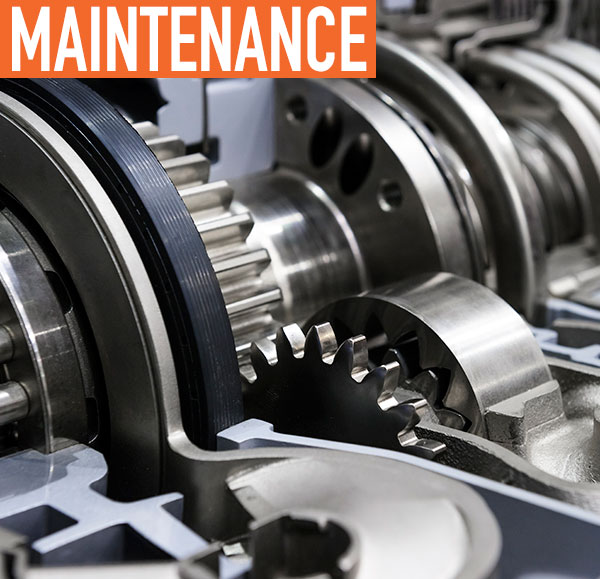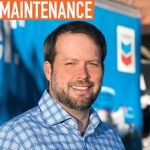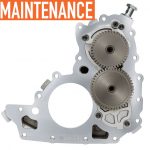Just the other day, in the shop, we were running a new truck and setting it up. The mechanics were asking why the transmission and gears make so much noise. Matter of fact, the whole diesel truck was noisy, even before we put together the power-take-off (PTO) and hydraulics. They were talking about the drivetrain, transmission, and PTO. After thinking about it for a while, it occurred to me there are a lot of reasons “there is noise” in the system. Not just gears grinding, rattling, and whining. Shafts spinning and shaking. Engines knocking and roaring out exhaust.
But, really, work trucks are quieter today due to better technology, which is driving the need for axillary power to do the same. Gear noise, whine, and rattle has been around a long time, but seems more noticeable. Likewise, gear noise is more noticeable today since engines and powertrains are better designed.
Some of the causes of gear noise can be attributed to gear quality, gear backlash, alignment, load, bearing endplay, and several others come to mind. Some being fluid level, manufacturing tolerances, drag, speed, and the hydraulic/PTO system itself. The following is an attempt to describe gear noise and how to reduce it to an acceptable level for the truck operator or end user.
GEAR QUALITY
Typically, gears are made from bar stock then parted off into blanks. After that, they can be bored, Hobbed, shaped, shaved, and heat-treated to the proper depth for required strength and wear. If need be, they can be ground to improve performance and to obtain a higher grade. The American Gear Manufactures Association (AGMA) has established the criteria the industry uses to evaluate and grade gears.
Some of the features they established are tooth form, shape, profile, finish and runout, and so on. Typically, the higher the grade, the better the overall gear quality. It is also fair to say the higher the AGMA number, the more it will cost to produce. So, there is a balance of cost vs. quality vs. noise we all have to understand. On the flip side, the lower the cost usually means less processing, hence a less expensive gear, which typically means a noisier gear box.

A typical look at the aperture at the nine o’clock position on an automatic transmission. Proper transmission gear alignment to the PTO gear is critical to reducing noise.
TRANSMISSION AND PTO
Whether the PTO is side-mount or rear-mount, there is some kind of gear or spline interface. The interface is between the transmission gear and PTO gear. For gears to fit or splines to mate, there needs to be some clearance between the two. On a side-mount, we call that backlash. If you read the installation specs, it is very common to have .006- to .012-inch backlash. This tolerance takes into account machining inconsistencies, part tolerance and stack-up, heat expansion, and fluid needs. The smaller the backlash the less likely to be noisy. But, if too tight, it will wear out faster and whine.
Gears run on bearings or on shafts with bearings. Bearing endplay also contributes to noise. Endplay greater than .003 inches is too much and causes noise and subsequent part damage over time. The objective is to have as little side-to-side movement between gears (less than .002 inches) and the bearing set as possible.
Deep ball roller bearings are good for this since they are not tapered. However, most input gears have tapered roller bearings due to side loading. These inherently have endplay and that allows the gear to move and vibrate. One of the best ways to reduce endplay and reduce gear noise is to ensure the endplay is removed. A simple but effective way is the use of an adjusting nut (jam nut) to snug up the bearing to the housing, virtually eliminating all endplay. This technological feature will reduce rattle and noise. There are other methods to fit these tapered bearings together as well, but not as effectively.

Gear set and adjusting nut, which is used to virtually eliminate bearing endplay and help reduce noise.
NOISE SOURCES
Fitting the bearing to the gear is important, but locating the PTO squarely to the transmission is very important, too. If supplied, make sure you use the guide pins to align the PTO gear to the transmission gear squarely. If not, there could be high spots or point contact between teeth. That will make a gear noise issue. Lastly, once the PTO is in place, make sure you torque the hardware in the proper sequence or pattern, per OEM spec.
One other thing to remember is the need for lubrication. There needs to be sufficient backlash and clearance so transmission fluid coats each tooth. This will help dampen noise. More importantly, fluid is needed to cool the moving parts by reducing friction and carrying away heat.
Heat typically builds up as the system is used and under load. Loose parts rattle, if there are any, and sometimes will go away when there is a load on the gear and things heat up. This happens for a couple of reasons. When the gears are under load, the entire gear train is in contact. It is much less likely to be affected by torsional vibration and tooth separation. The other item is friction or drag. Drag in the gear train helps keep the gears from vibrating. So, less vibration correlates to reducing gear noise. Some PTO have drag adjustment in their PTOs. If too much drag is induced, the clutch plates can wear out faster.
As a side note to rattle, when engineers design gears and gear sets, they evaluate contact ration. There is a contact ratio they strive for. The higher the contact ratio, the stronger the tooth carrying load since more teeth share the load. Gear sets with 1.2 contact ratio or higher typically are more quiet than 1.1 ratio or less. The smaller the ratio, the more clearance between teeth and more opportunity to hear rattle.

On some applications, a drive line is attached to the PTO. If not set up correctly, it can cause vibration and noise.
SYSTEM OVERALL
The noise from the system is not just the cause and effects of the transmission and PTO gears. Some of the time, there are u-joints and a driveline creating the noise. There are a few things to remember about drivelines:
- Make sure u-joints are in phase.
- Ensure the driveline is balanced.
- Apply a healthy amount of grease in all u-joints.
- Drivelines should be supported about every 36 inches to avoid excessive shaft deflection and vibration.
- The angle of offset between the ends of the drive shaft needs to be kept as small as possible. Typically, seven degrees is max, but it all depends on the rpms, so it could be a little more or less.
Consult a driveline specialist if in doubt, because a poorly designed drive will make you think the transmission or PTO is bad. And, if you run it long enough, it will destroy the gears.
ENVIRONMENT AND NOISE
Just a short note here: Noise is subjective. It is not easy to measure or quantify. It is also very important to remember that inside a shop, sitting on a concrete floor with metal walls and ceiling, any sound can be harsh. Put the same truck outside in the grass and fresh air, it may be a lot quieter.

This exploded assembly view helps mechanics find replacement parts and how they go together.
NOISE REDUCTION
Gear noise, whine, and rattle are big customer concerns. Let’s face it, loud noise is a sign of poor quality. PTO and gear manufactures and users of gear sets are working together to balance noise, rattle, and cost. Engineers, upfitters, and manufacturing folks are working with customers to produce the most quite gear set and mobile power system economically available. This is not easy since there are a multitude of issues and people involved.
It is also important to point out each part or feature in the system can help or hurt the noise level. The above items mentioned and their significance will hopefully help troubleshoot any problem found. Now, knowing these and other surrounding issues, we can get the noise down and get out there building our world.
ABOUT THE AUTHOR:
Mikel Janitz is an OEM applications engineer for Bezares USA, a global leader in PTO engineering & design. Mikel graduated from Oklahoma State University with a BS and MS in Engineering/Management. He works in Tulsa, OK, and holds several patents. Mikel can be reached by email: m.janitz@bezares.com.
_______________________________________________________________________
MODERN WORKTRUCK SOLUTIONS: MAY 2016 ISSUE
Did you enjoy this article?
Subscribe to the FREE Digital Edition of Modern WorkTruck Solutions magazine.
![]()




